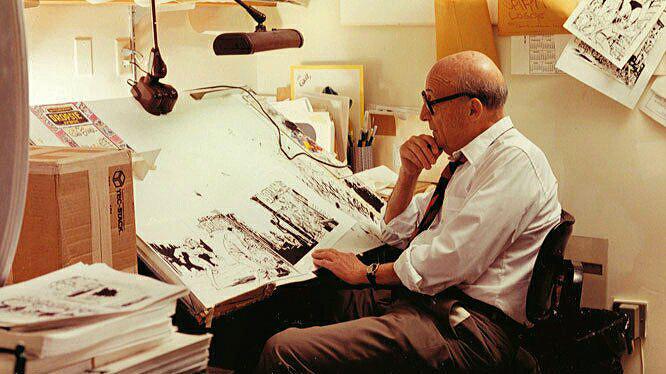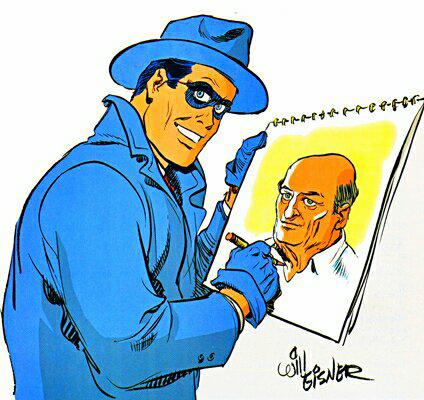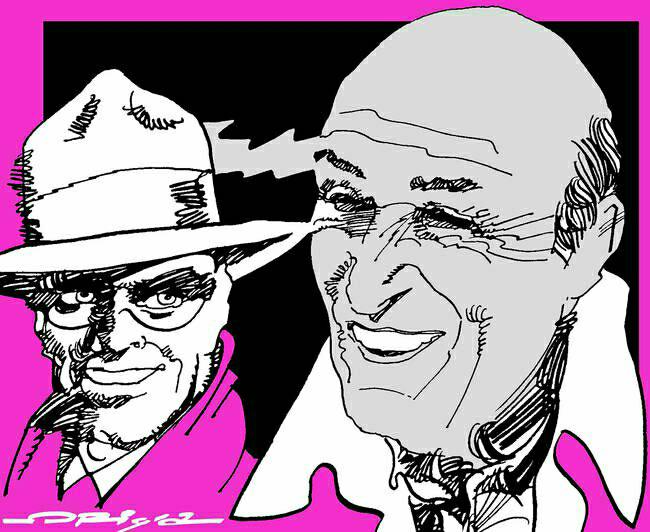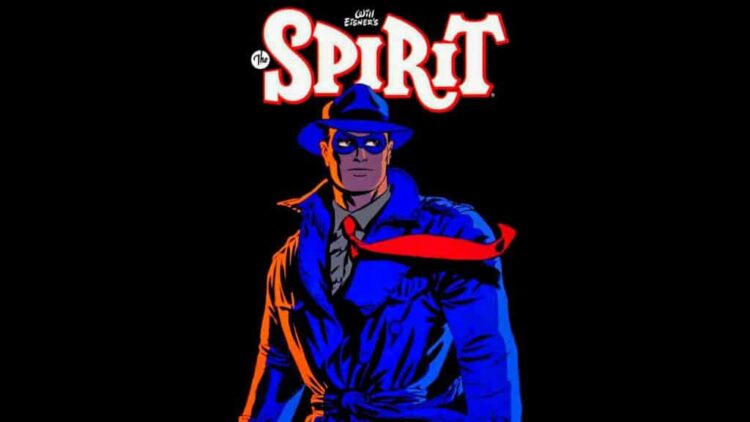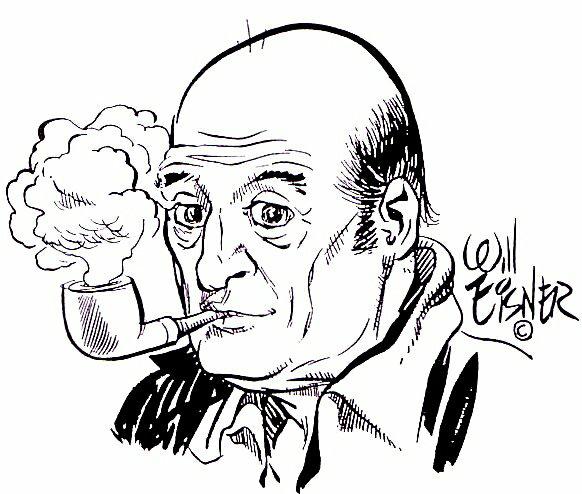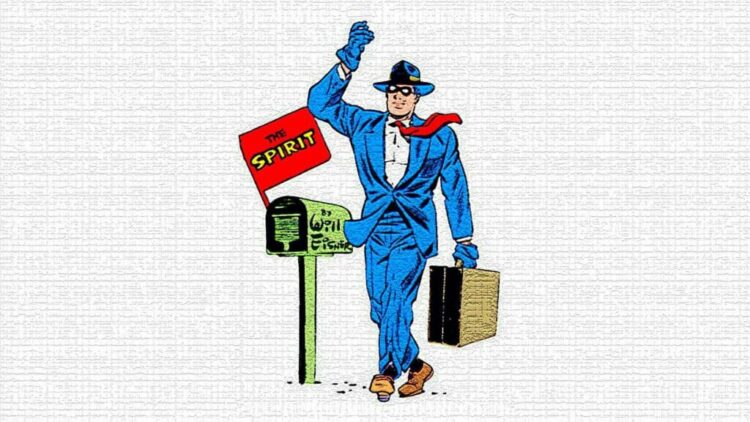Eisner: The Man. The Myth. The Legend. The Storyteller. The Genius. By Matthew Rizzuto
As the supreme master of sequential storytelling, Will Eisner really needs no introduction, but I’ll attempt a suitable blurb anyway. Best known as the creator of The Spirit and writer/artist on a number of graphic novels, Will Eisner was also a passionate voice for the educational use of comics and the advancement of sequential art, the academic name he gave the art form, as a practical form of communication, universally recognized and clearly understood. Born on March 6, 1917, William Erwin Eisner was that incredibly rare combination of master storyteller, artist and a savvy businessman. Starting off in the 1930’s with work in the fledgling comics industry, Eisner quickly rose to become one of the powerhouses of the burgeoning publishing world. He started one of the first comics shops with Jerry Iger, where freelance writers and artists created content for other publishers. As sales increased and the fees rose, brand-new employees were taken in, like Bob Kane and a 17-year-old Jacob Kurtzberg, who became Jack Kirby.
Under that name, Kirby helped create a series of superheroes for Marvel Comics, including Captain America, The Incredible Hulk, The X-Men and so many countless others. However, Eisner wasn’t a flawless talent scout. When two kids out of Cleveland, Ohio named Jerry Siegel and Joe Shuster mailed in some ideas for a new strip about a bulletproof man from another world that could fly, he turned them down cold. Eisner informed them that “weren’t ready to come to New York” and that “their style wasn’t professional yet.” Eisner’s biographer, Michael Schumacher wrote, “In one of the few giant missteps in a career characterized by strong instincts and judgment, Eisner shot down Superman.” No harm done. After the first publishing of Clark Kent and his secret identity in Action Comics #1 on April 18th, 1938, it didn’t really matter. Superheroes were absolutely everywhere!!! Eisner made a deal to launch “The Spirit” in 1940. His noirish superhero without fantastic superpowers or a costume, just a domino mask, a business suit, a fedora and his wits, in a weekly comics supplement that was distributed in Sunday newspapers. It successfully ran from 1940 to 1952. At its peak, The Spirit appeared in 20 newspapers across the country, reaching over 5 million readers.
When Eisner ended it in 1952, he moved on to conquer new worlds, including working with the US Army on PS magazine, a comics-styled publication that taught maintenance techniques to soldiers. In the mid-1960’s, during the pop art and the campy “Batman” television show craze, Jules Feiffer (Eisner’s assistant at one point in the 1950’s), wrote and compiled “The Great Comic Book Heroes”, a paean to the beloved comics of his youth. The Spirit was included. In 1965, Feiffer’s “The Great Comic Book Heroes” took the high road and noted Feiffer, “The form gained a new lease on life and new respect, none of which interests me particularly, except in what I did to redeem Will Eisner’s career. This was a guy who was no longer heard of, was completely forgotten, had forgotten himself and was no longer doing comics. I was happy that, in a sense, I was able to bring him back from the dead or at the very least, from exile.” When you think about it, he never really went in exile because Eisner never left. You have to consider the unparalleled genius of the man. Eisner was not just a writer, not just an artist, but was also a smart businessman. We can’t forget that Eisner had the forethought to get the rights to his characters, something that the majority of comics creators never accomplished.
Very few creators in the history of the medium of comics ever owned any of their own characters. Jerry Siegel and Joe Shuster, Superman’s creators, never really owned The Man of Steel. The same can be said for Jack Kirby and Bob Kane. Bob Kane who co-created Batman with Bill Finger, never owned the character either. In fact, he just got a really good deal…by leaving Bill Finger out in the cold. What a putz. Later on, The Spirit was reborn in Harvey Comics first reprinted some of the classic stories in two “giant” comics. In the 1970’s, Jim Warren reprinted The Spirit in magazine format and black and white, with select stories recolored. After the Warren run, Eisner teamed with publisher and cartoonist, Denis Kitchen, who brought The Spirit back in a series of publications and also offered Eisner the opportunity to tell new stories in “The Will Eisner Quarterly”. Eisner had been intrigued by underground comix (which Kitchen published) in the late 1960’s and the freedom they allowed their cartoonists to express. That freedom drew Eisner back into comics. It was in 1978 that Eisner found his second act with the publication of his graphic novel, “A Contract With God”. Soon after that, Eisner became an educator, teaching kids about comics history and what they could accomplish in the field, if they so desired. Over the next 25 years, the writer/artist produced over 15 new graphic novels, until his unfortunate death in 2005. Will Eisner was a powerful presence at the famous San Diego Comic-Con from his first appearance at the event in the mid-1970’s until 2004.
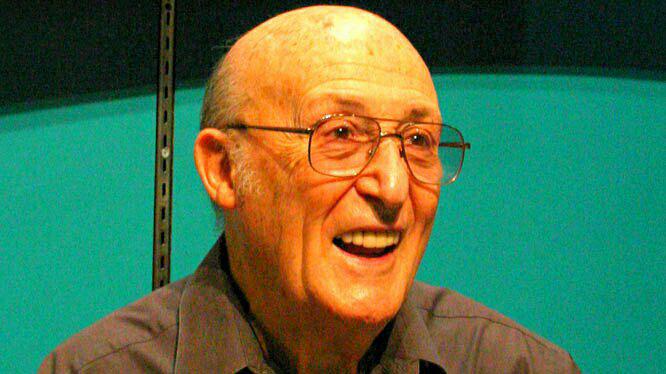
He was the guiding force behind both The Will Eisner Comic Industry Awards and The Will Eisner Spirit of Comics Retailer Award. In his latter years, he appeared each year at the show, standing onstage to welcome each recipient of his namesake awards. He was not only an amazing writer and artist, but also a mentor and friend to everyone. Of course, that should come to no surprise to anyone. Again, that’s Eisner: The Man. The Myth. The Legend. The Storyteller. The Genius. Sometimes, rereading his stories reminds me that I miss Will Eisner the storyteller, the craftsman, the dreamer, the artist. It isn’t yet easy or comfortable for me to write about Will Eisner. He was too important, unbelievably magnanimous and writing this reminds me how much I miss the legendary Will Eisner. When Eisner died in 2005, he was as respected and as revered around the world as he would let us respect and revere him. He was an educator and an innovator. He started out so far ahead of the game that it took the rest of the world literally 60 years to catch up. There are moments when the world is slow. When it comes to Eisner, that’s fact. Eisner’s life is, in miniature, a history of the outstanding medium of comics. He was one of the very first people to run a studio making commercial comic books, but while his contemporaries dreamed of getting out of that ghetto and into more lucrative and respectable places – advertising, perhaps or illustration or even fine art – Will had no desire to escape. He was trying to create a majestic art form. In seven pages, normally less than 60 panels, he could build a short story worthy of O Henry. It doesn’t matter if it was about heroes or villains, funny or tragic, sentimental or hardbitten or simply odd. The work was uniquely comics, existing in the place where the words and the pictures come together, commenting on each other, reinforcing each other. Eisner’s stories were influenced by film, by theatre, by radio, but were ultimately their own medium, created by a man who thought that comics was an art form and who was proved right. Always right. Constantly correct.
There are arguments today about whether or not Will was actually the first person to coin the term “graphic novel” for his 1978 book of short stories “A Contract With God”, the book that kicked off the third act of his creative life. There are far fewer arguments about what he actually did in the 1940’s with The Spirit stories or about the influence he had on the world of comics throughout his creative life. I’ll step forward here: I bought my first copy of The Spirit in 1991 in a basement comics shop. I saw it hanging on a wall and knew that, whatever it was, I wanted it. I would have been about 14. Reading it on the way home, I had no idea that the tales I was reading were over 30 years old. They were fresher and smarter than anything I’d seen in comics. Great stories that somehow managed to leave out everything that wasn’t the story, while telling wonderful tales of beautiful women and unfortunate men, of human fallibility and of occasional redemption, stories through which The Spirit would wander, bemused and often beaten up. Of course, that is The Spirit: A McGuffin in a mask and hat.
I loved The Spirit then. I loved the choices that Will made, the confidence, the way the art and the story meshed. I read those stories and I wanted to write comics, too. The Spirit by Will Eisner reeks of brilliance. You can’t negotiate with genius. You’ll lose every time. The Spirit, which began in 1940 and continues to this day, despite Eisner’s death, with new editions by other writers and artists. I will admit, there are moments where I wanted to stop reading comics, disappointed and disillusioned by the medium as only a 16-year-old can be, but even then, I kept reading The Spirit. I read those stories with unalloyed pleasure and when, as a 25-year-old, I decided it was time to learn how to write comics. I went out and bought Eisner’s “Comics and Sequential Art” and pored over it, like a rabbinical student studying his Torah and then time went on and all of a sudden, I wanted to write comics. I remember watching some footage once of Eisner receiving an award for lifetime achievement in Germany. The thrill of seeing over a thousand people on their feet and clapping until their hands hurt and carrying on clapping!!! He looked modestly embarrassed, while his wife Ann beamed like a lighthouse in the darkness. You must remember there are places on Earth where the world fades out into a kind of warm autumnal haze.
Can you imagine spending almost a week together with Will and Ann Eisner and comics creators Jaime and Koko Hernandez and Sandman creator Neil Gaiman. Basically, a tight-knitted group of people who spoke no Spanish? What a breathtaking experience!!!! One day, Ann and Will and Neil Gaiman walked down along the edge of the sea. They walked for a couple of miles, talking about the history of comics and the future of the medium and the people Will had known. It was like a guided tour of the medium that they adored and truly loved. Discussing and critiquing the work and the genius of Jerry Siegel and Joe Shuster, Bill Finger and Bob Kane, Jack Kirby and Steve Ditko, Jim Steranko and Stan Lee, Ramona Fradon and Joe Simon and so many countless others. It has been said that Gaiman found himself hoping that when he gets to be Eisner’s age, he could be that sharp, that wise and that funny. For all the acclaim heaped upon him, he was generous, modest, distinguished, yet self-deprecating. He took his work seriously, never himself. More evidence of how incredibly missed Eisner still is. Eisner: The Man. The Myth. The Legend. The Storyteller. The Genius.
Thank You.
join us for more discussion at the CBH Facebook group
get historic comic CBH Merchandise
check out our CBH Youtube Channel
check out our CBH Podcast available on Apple Podcasts, Google PlayerFM and Stitcher.
Images are not intended to infringe on copyright, but rather used for academic purpose.
Spirit© Will Eisner, Photos ©Their Respective Copyright holders
The opinions of any one article do not reflect the intentions of the website.








